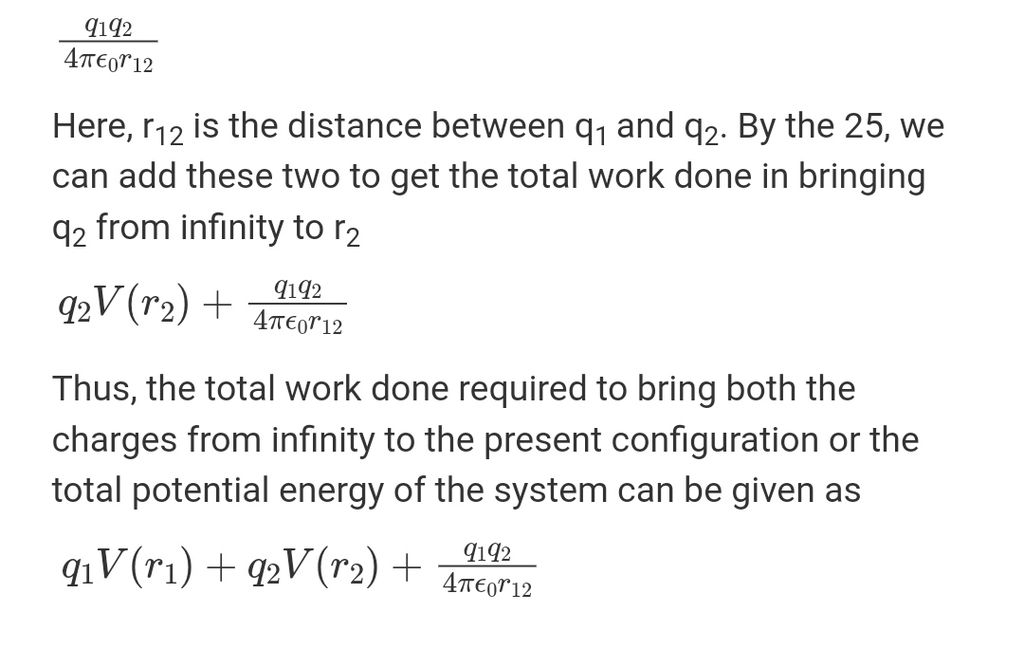- Books Name
- Physics Book Part l and ll
- Publication
- Grow Career Publication
- Course
- CBSE Class 12
- Subject
- Physics
Potential energy
Potential energy of a system charge
Electric Potential Energy of a System of Charges Electric potential energy of a system of charges is equal to amount of work done in forming the system of charges by bringing them at their particular positions from infinity without any acceleration and against the electrostatic force. It is denoted by U.
U=W=qV(r)
Potential energy in an external field

consider a system of two charges q1 and q2 located at a distance r1 and r2 from the origin. Let these charges be placed in an external field of magnitude E. Let the work done in bringing the charge q1 from infinity to r1 be given as q1V(r1)and the work done in bringing the charge q2 from infinity to r2 against the external field can be given as q2V(r2).
Potential energy of a dipole in an external field
Consider a dipole with charges q1 = +q and q2 = –q placed in a uniform electric field E, in a uniform electric field, the dipole experiences no net force; but experiences a torque τ given by τ = p×E which will tend to rotate it (unless p is parallel or antiparallel to E).
ELECTROSTATICS OF CONDUCTORS
1. Inside a conductor, electrostatic field is zero
There may also be an external electrostatic field. In the static situation, when there is no current inside or on the surface of the conductor, the electric field is zero everywhere inside the conductor. This fact can be taken as the defining property of a conductor.
2. At the surface of a charged conductor, electrostatic field must be normal to the surface at every point
We can say that, if the electric field lines were not normal at the surface, a component of the electric field would have been present along the surface of a conductor in static conditions. Thus, free charges moving on the surface would also have experienced some force leading to their motion, which does not happen. Since there are no tangential components, the forces have to be normal to the surface.
3. The interior of a conductor can have no excess charge in the static situation
A neutral conductor has equal amounts of positive and negative charges In every small volume or surface element. When the conductor is charged, The excess charge can reside only on the surface in the static situation. This follows from the Gauss’s law.
4. Constant electrostatic potential throughout the volume of the conductor:
The electrostatic potential at any point throughout the volume of the conductor is always constant and the value of the electrostatic potential at the surface is equal to that at any point inside the volume.
5. Electric field at the surface of a charged conductor
Here σ is the surface charge density and nˆ is a unit vector normal to the surface in the outward direction. To derive the result, choose a pill box (a short cylinder) as the Gaussian surface about any point P on the surface. The pill box is partly inside and partly outside the surface of the conductor. It has a small area of cross-section δ S and negligible height.
DIELECTRICS AND POLARISATION
The Dielectric Constant is the ratio of the applied electric field strength to the strength of the decreased value of the electric field capacitor when a dielectric slab is placed between the parallel plates. The formula is as follows:
εr = E0 / E
where E0 is the applied electric field, E is the net field, & εr is the dielectric constant.The greater the dielectric constant, the greater the amount of charge that can be held. The capacitance of a capacitor is increased by a factor of the dielectric constant when the gap between the plates is completely filled with a dielectric. C = εr C0, where C0 is the capacitance between the plates with no dielectric.

 Madhava Publications
Madhava Publications
 Grow Career Publication
Grow Career Publication
